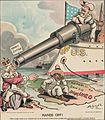Roosevelt Corollary facts for kids
The Roosevelt Corollary was an important idea added to the Monroe Doctrine by U.S. President Theodore Roosevelt in 1904. He announced it during his yearly speech to Congress, called the State of the Union address. This happened after a problem in Venezuela between 1902 and 1903. The Corollary basically said that the United States could step in to help countries in Latin America if they had trouble paying their debts to European nations. This was to stop European countries from using force to collect money.
Contents
What Was the Roosevelt Corollary?
The Roosevelt Corollary was an addition to the Monroe Doctrine. It was a statement by President Theodore Roosevelt in 1904. He said that the United States had the right to act as an "international police power" in Latin American countries. This meant the U.S. could get involved if these countries were not managing their money well or if they were causing problems for European nations.
Why Was It Created?
The main reason for the Roosevelt Corollary was to prevent European countries from interfering in Latin America. In the early 1900s, some European nations, like Germany and Britain, were threatening to use military force against countries like Venezuela and the Dominican Republic. These countries owed money to European banks and governments. Roosevelt worried that if European powers sent their navies or armies to collect debts, it would go against the Monroe Doctrine.
The Venezuela Crisis of 1902–03
A big event that led to the Corollary was the Venezuela Crisis of 1902–03. Venezuela owed money to several European countries. When Venezuela couldn't pay, Britain, Germany, and Italy sent warships to block Venezuelan ports. They even bombed some forts. The United States was worried about this European military action so close to its borders. President Roosevelt helped to settle the dispute peacefully. But he realized that similar problems could happen again.
How Did It Change U.S. Policy?
The Roosevelt Corollary changed the way the U.S. acted in the Western Hemisphere. Before this, the Monroe Doctrine mostly said that Europe should stay out. The Corollary added that the U.S. would step in if countries in Latin America couldn't keep order or pay their debts. This meant the U.S. would sometimes send its military or financial experts to these countries. It was a way for the U.S. to show its growing power and influence in the region.
"Big Stick" Diplomacy
The Roosevelt Corollary is often linked to President Roosevelt's "Big Stick" diplomacy. This idea meant that the U.S. should speak softly but carry a "big stick," meaning a strong military. The threat of U.S. military action was supposed to make countries behave and prevent European interference. For example, the U.S. took control of the customs (tax collection) in the Dominican Republic to make sure its debts were paid.
Impact and Legacy
The Roosevelt Corollary was used many times by the U.S. in the early 20th century. It led to U.S. military interventions in countries like the Dominican Republic, Cuba, Nicaragua, and Haiti. While it aimed to prevent European involvement, it also meant that the U.S. often interfered in the internal affairs of Latin American nations. This created mixed feelings in the region. Some saw it as protection, while others saw it as unwanted control.
Later Changes to U.S. Policy
Over time, the U.S. began to move away from the Roosevelt Corollary. In the 1930s, President Franklin D. Roosevelt introduced the "Good Neighbor Policy." This policy emphasized cooperation and non-intervention in Latin America. It marked a shift from the "Big Stick" approach to a more friendly relationship with countries in the region.
Images for kids
-
Political cartoon depicting Theodore Roosevelt using the Monroe Doctrine to keep European powers out of the Dominican Republic.
See also
 In Spanish: Corolario de Roosevelt para niños
In Spanish: Corolario de Roosevelt para niños


